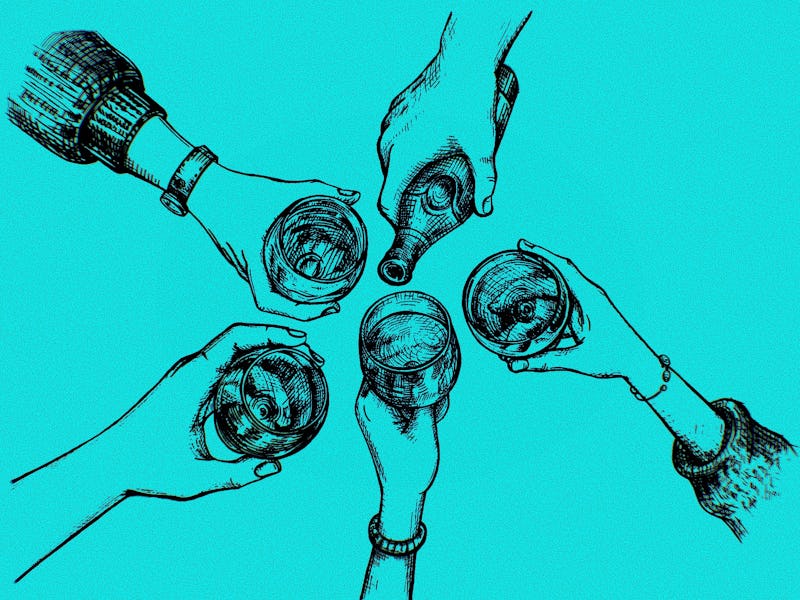Scientists discover "just one drink" is more accurate than they thought
One binge drinking session may make all the difference.

Plenty of people drink alcohol in a way that doesn’t lead to lasting dependency. But for millions of people, a casual drinking habit can transform into a compulsive one, leaving scientists wondering where people go off the rails — and how to stop them.
Detecting signs of an alcohol problem before it actually emerges may help. A new analysis involving binge-drinking male mice could represent the first step in understanding how the spiral starts.
Kay Tye, a neuroscientist at Salk Institute for Biological Studies and lead author of the study, tells Inverse that the very first time certain mice were exposed to alcohol, they showed patterns of brain activity consistent with those that underpin compulsive drinking. Several weeks later, these mice had become binge drinkers.
“The neural activity was so different during initial alcohol exposure, when the behavior looked indistinguishable,” Tye says. “The degree of reduced neural activity in this key circuit could so accurately predict the future development of compulsive behavior, weeks later!”
The analysis was published this week in the journal Science.
Scientists are unsure why some people develop alcohol use disorder and others don't, but activity in the brain could provide new clues.
“Just one drink”
When scientists search for biological causes of alcohol abuse, they tend to look at genes for clues. There are hundreds of genes associated with alcohol use, but genetics alone can’t account for all the reasons that some people develop problems with alcohol and others don’t.
"The thing that really produced these individual differences was when we allowed them to have a binge drinking experience."
In this study, researchers turned instead to the brain. They found that in mice who went on to develop a drinking problem, alcohol triggered different responses in neurons running through a brain circuit stemming from the prefrontal cortex, which plays a role in decision-making, to an area of the brain stem known as the dorsal periaqueductal gray, which is involved in more fundamental brain processes.
When mice that didn’t develop an alcohol problem drank for the first time, they saw that this circuit seemed particularly active. But in the mice that did become problem drinkers, the circuit’s activity was tamped down.
These differences were obvious before the mice started behaving differently around alcohol, says Cody Siciliano, who is assistant professor at Vanderbilt University and a study co-author.
The mice started to change their behavior after one critical experience — one that many of us humans experience in our lifetimes, too.
“The thing that really produced these individual differences was when we allowed them to have a binge drinking experience,” Siciliano tells Inverse.
What binge drinking does to the brain
In the experiment, Tye’s team followed genetically identical mice as they experimented with alcohol. This started with one or two drinks here and there. After a period of getting the mice used to these small amounts of alcohol, the researchers let the mice go off the rails, allowing them to drink unlimited amounts of alcohol for two hours straight.
After a binge-drinking episode, some mice developed compulsive behaviors around alcohol.
That binge experience proved to be transformative — but especially for the mice who had shown lower-than-expected responses to alcohol in the prefrontal cortex-brain stem circuit. These mice didn’t have casual relationships with alcohol anymore. Instead, they showed more compulsive drinking than their cage-mates
Little could put the binge-drinking mice off the booze, the researchers found. Mixing the alcohol with quinine to give it a bitter taste or giving the mice foot shocks after they drink did not stop them from compulsive drinking.
The findings suggest that drinking inhibits an “aversive” signal in the brains of compulsive drinkers. In mice who did not compulsively drink, that aversive signal was associated with steering clear of too much alcohol. But alcohol may also cloud a mouse’s ability to make a judgement call, the researchers say.
“What we think is happening is that in some animals this neural circuit from the prefrontal cortex into the dorsal periaqueductal gray is basically susceptible to the effects of alcohol,” Siciliano says. “We think that this pathway is important for decision-making in a number of different contexts. It doesn’t very well after this binge drinking experience.”
A mouse brain is not a human brain, so it could be years before these findings lead to a kind of treatment for alcoholism. But the results are promising, the researchers say.
The same brain circuit may hold clues to treating the problem. To see whether this was the case, the team used optogenetics to alter the binge-drinking mice’s brain activity to mimic that seen in the non-alcoholic mice.
Activating the circuit appears to decrease drinking activity in the mice in a lasting way, Siciliano says.
“If there was a way to do that in humans that could be therapeutically advantageous and have a lasting effect,” he says.
Manipulating human brains using the same technique isn’t a viable option. But in the future, the team hopes that they might be able to find a target which would allow them to manipulate the neural activity using drugs — tackling alcohol addiction before it even starts.
Abstract:
What individual differences in neural activity predict the future escalation of alcohol drinking from casual to compulsive? The neurobiological mechanisms that gate the transition from moderate to compulsive drinking remain poorly understood. We longitudinally tracked the development of compulsive drinking across a binge-drinking experience in male mice. Binge drinking unmasked individual differences, revealing latent traits in alcohol consumption and compulsive drinking despite equal prior exposure to alcohol. Distinct neural activity signatures of cortical neurons projecting to the brainstem before binge drinking predicted the ultimate emergence of compulsivity. Mimicry of activity patterns that predicted drinking phenotypes was sufficient to bidirectionally modulate drinking. Our results provide a mechanistic explanation for individual variance in vulnerability to compulsive alcohol drinking.